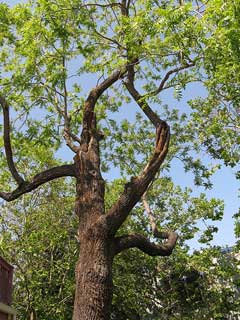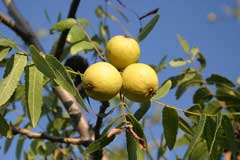 |
|
http://www.flickr.com/photos/flit/2431342472/ |
 |
| http://www.flickr.com/people/38213125@N00 |
Translate this page:
Summary
California Walnut (J. californica) seed is eaten raw, cooked or used in pies, cakes, biscuits, and confections. It has a sweet flavour and is said to have a better flavour than Juglans nigra. Walnut species have similar cultivation requirements requiring a neutral to alkaline soil. Black walnuts can tolerate drier soils. Walnuts take light shade in the early stages of development, but full sun is ideal. The root pattern is a taproot. Walnuts are good trees for irregular and strip intercropping systems. Interplanting walnuts with a nitrogen-fixing plant, such as Silverberry (Elaeagnus × ebbingei) or autumn Olive (Elaeagnus umbellata) and various Alnus species results in a 30% increase in tree height and girth. Note: Walnuts secrete chemicals into the soil which inhibit other plants, especially apples (Malus species), members of the Ericaceae, Potentilla spp., tomatoes, and the white pines (certain Pinus spp.). Juglans species,
Over 18m (60ft) high, several fast-growing large walnut tree species are useful in food forests. All trees are deciduous with native species available in Northern America and Europe. Important species are Common Walnut (J. regia) and Black Walnut (J. nigra) (heat-tolerant in zones 9 through 5). The raw edible seed is a rich source of protein, dietary fibre, B vitamins and several dietary minerals, particularly manganese. It has 14% carbohydrates, 15% protein and 65% fat. The nuts ripen in autumn and can be eaten at this stage, but tend to have a rubbery texture. Usually, it is better to dry them which will also mean they keep well. Eat the nuts raw or use them in confections, cakes or ice cream. They have a delicious flavour. The nut is ground into a meal and used as a flavouring in sweet and savoury dishes. For more extended storage, unripe nuts are pickled in vinegar. The nut oil is edible but goes rancid quickly. It has a pleasant flavour and is used in salads or for cooking. In spring, the sap is tapped and boiled down to a syrup or sugar or added to maple syrup.
Physical Characteristics

 Juglans californica is a deciduous Tree growing to 6 m (19ft 8in) at a medium rate.
Juglans californica is a deciduous Tree growing to 6 m (19ft 8in) at a medium rate.
See above for USDA hardiness. It is hardy to UK zone 8. It is in flower from April to May. The species is monoecious (individual flowers are either male or female, but both sexes can be found on the same plant) and is pollinated by Wind. The plant is self-fertile.
It is noted for attracting wildlife.
Suitable for: light (sandy), medium (loamy) and heavy (clay) soils and prefers well-drained soil. Suitable pH: mildly acid, neutral and basic (mildly alkaline) soils. It cannot grow in the shade. It prefers moist soil.
UK Hardiness Map
US Hardiness Map
Synonyms
Plant Habitats
Woodland Garden Canopy;
Edible Uses
Edible Parts: Oil Seed
Edible Uses: Oil
Seed - raw, cooked or used in pies, cakes, biscuits, confections etc[183]. A sweet flavour[229]. The seed is small with a thick shell but it makes good eating and is said to have a better flavour than Juglans nigra[183]. The seed is up to 15mm in diameter[229]. The seed ripens in late autumn and, when stored in its shell in a cool place, will keep for at least 6 months[K]. An edible oil is obtained from the seed, it tends to go rancid quickly.
References More on Edible Uses
Medicinal Uses
Plants For A Future can not take any responsibility for any adverse effects from the use of plants. Always seek advice from a professional before using a plant medicinally.
Blood tonic
An infusion of the leaves is used to treat thin blood[257].
References More on Medicinal Uses
The Bookshop: Edible Plant Books
Our Latest books on Perennial Plants For Food Forests and Permaculture Gardens in paperback or digital formats.

Edible Tropical Plants
Food Forest Plants for Hotter Conditions: 250+ Plants For Tropical Food Forests & Permaculture Gardens.
More

Edible Temperate Plants
Plants for Your Food Forest: 500 Plants for Temperate Food Forests & Permaculture Gardens.
More

More Books
PFAF have eight books available in paperback and digital formats. Browse the shop for more information.
Shop Now
Other Uses
Herbicide Oil Rootstock Wood
This species is sometimes used as a rootstock for the common walnut, Juglans regia[183]. Plants produce chemicals which can inhibit the growth of other plants. These chemicals are dissolved out of the leaves when it rains and are washed down to the ground below, reducing the growth of plants under the tree[18, 20, 159]. The roots of many members of this genus produce substances that are toxic to many plant species, especially apples (Malus species), members of the Ericaceae, Potentilla spp and the white pines (certain Pinus spp.)[200]. Wood - moderately coarse-grained. An attractive wood, but the frequent branching pattern of the trunk limits the use of this wood commercially[229]. 1. Nectary - Flowers rich in nectar and pollen:
No – Walnut trees are wind-pollinated, so their flowers do not produce large amounts of nectar or pollen that would attract pollinators like bees.
2. Wildlife - Food (Fruit, Seeds, Leaf litter, Shelter, Nesting, Roosting):
Yes – Walnuts provide food in the form of nuts, which are consumed by various birds, small mammals, and other wildlife. The tree’s structure and dense canopy also offer shelter, nesting, and roosting opportunities for birds.
3. Invertebrate Shelter (Overwintering sites, Leaf litter, Groundcover):
Yes – Walnut trees produce leaf litter, and their bark and wood structure can provide overwintering sites for various invertebrates.
4. Pest Confuser (Smell):
No – Walnuts do not emit a strong odor that confuses pests, though they do produce juglone, a compound that can inhibit the growth of some plants nearby but doesn’t directly confuse pests. Juglans species can be used in agroforestry for shade and as a nitrogen-fixing tree. They also provide valuable timber and can enhance biodiversity in mixed plantings.
Special Uses
References More on Other Uses
Cultivation details
Requires a deep well-drained loam and a sunny position sheltered from strong winds[1, 11]. Prefers a slightly alkaline soil[200]. Plants are not very hardy in Britain, tolerating temperatures down to between -5 and -10°c[200]. A fairly fast-growing tree in its native habitat, but quite short-lived, dying after about 125 - 150 years[229]. Plants produce a deep taproot and they are intolerant of root disturbance[1, 11]. Seedlings should be planted out into their permanent positions as soon as possible and given some protection since they are somewhat tender when young[1, 11]. Flower initiation depends upon suitable conditions in the previous summer[200]. The flowers and young growths can be destroyed by even short periods down to -2°c, but fortunately plants are usually late coming into leaf[200]. Any pruning should only be carried out in late summer to early autumn or when the plant is fully dormant otherwise wounds will bleed profusely and this will severely weaken the tree[200]. Trees have a dense canopy which tends to reduce plant growth below them. We have no specific information for this species, but the roots of several members of this genus produce substances that are toxic to many plant species, especially apples (Malus species), members of the Ericaceae, Potentilla spp and the white pines (certain Pinus spp.)[200]. The leaves of many species also secrete substances that have an inhibitory affect on plants growing underneath them. All in all this is not a very good companion plant[K]. Closely related to J. hindsii[183, 200]. Walnuts are usually harvested in autumn when the husks begin to split and turn brown.
Walnuts generally flower in spring producing long catkins for male flowers and clusters for female flowers. Walnuts are moderate to fast-growing trees, typically reaching maturity in about 10 to 15 years, depending on the species and growing conditions. Juglans californica, also known as the California walnut, is self-fertile. However, self-fertilization can be prevented because male flowers shed pollen before female flowers on the same tree are ready to receive it.
References Carbon Farming Information and Carbon Sequestration Information
Temperature Converter
Type a value in the Celsius field to convert the value to Fahrenheit:
Fahrenheit:
The PFAF Bookshop
Plants For A Future have a number of books available in paperback and digital form. Book titles include Edible Plants, Edible Perennials, Edible Trees,Edible Shrubs, Woodland Gardening, and Temperate Food Forest Plants. Our new book is Food Forest Plants For Hotter Conditions (Tropical and Sub-Tropical).
Shop Now
Plant Propagation
The seed is best sown as soon as it is ripe in individual deep pots in a cold frame[80]. You need to protect it from mice, birds, squirrels etc. The seed usually germinates in late winter or the spring. Plant out the seedlings into their permanent positions in early summer and give some protection from the cold for their first winter or two. The seed can also be stored in cool moist conditions (such s the salad compartment of a fridge) over the winter and sown in early spring but it may then require a period of cold stratification before it will germinate[78, 80].
Other Names
If available other names are mentioned here
Native Range
NORTHERN AMERICA: United States (California (southwest))
Weed Potential
Right plant wrong place. We are currently updating this section.
Please note that a plant may be invasive in one area but may not in your area so it's worth checking.
Conservation Status
IUCN Red List of Threatened Plants Status :

| Related Plants
|
| Latin Name | Common Name | Habit | Height | Hardiness | Growth | Soil | Shade | Moisture | Edible | Medicinal | Other |
| Juglans ailanthifolia | Japanese Walnut | Tree | 20.0 |
4-8
| | LMH | N | M | 3 | 1 | 5 |
| Juglans ailanthifolia cordiformis | Heartseed Walnut | Tree | 20.0 |
4-8
| M | LMH | N | M | 4 | 1 | 4 |
| Juglans cathayensis | Chinese Walnut | Tree | 20.0 |
4-8
| | LMH | N | M | 3 | 0 | 1 |
| Juglans cinerea | Butternut - White Walnut, Butternut | Tree | 25.0 |
3-7
| M | LMH | N | M | 3 | 3 | 3 |
| Juglans hindsii | Hind's Black Walnut, Northern California walnut, Paradox hybrid walnut | Tree | 15.0 |
8-9
| M | LMH | N | M | 3 | 0 | 3 |
| Juglans intermedia | Hind's Black Walnut, Northern California walnut, Paradox hybrid walnuH | Tree | 30.0 |
4-8
| | LMH | N | M | 3 | 0 | 1 |
| Juglans major | Arizona Walnut | Tree | 15.0 |
8-11
| F | LMH | N | M | 2 | 0 | 2 |
| Juglans mandschurica | Manchurian Walnut | Tree | 20.0 |
4-8
| | LMH | N | M | 3 | 1 | 4 |
| Juglans microcarpa | Texas Walnut, Little walnut, Stewart's little walnut | Tree | 10.0 |
5-9
| | LMH | N | M | 2 | 0 | 3 |
| Juglans neotropica | Andean Walnut | Tree | 25.0 |
10-12
| S | LMH | N | M | 3 | 2 | 4 |
| Juglans nigra | Black Walnut | Tree | 30.0 |
4-9
| F | LMH | N | M | 3 | 3 | 4 |
| Juglans olanchana | Olancho walnut, Central American walnut | Tree | 45.0 |
10-12
| M | LMH | SN | MWe | 2 | 0 | 3 |
| Juglans regia | Walnut, English walnut, Persian Walnut, | Tree | 20.0 |
7-9
| M | LMH | N | M | 4 | 3 | 4 |
| Juglans regia fallax | Walnut | Tree | 30.0 |
4-8
| | LMH | N | M | 3 | 0 | 1 |
| Juglans regia kamaonia | Walnut | Tree | 30.0 |
4-8
| | LMH | N | M | 3 | 3 | 3 |
| Juglans sinensis | | Tree | 20.0 |
-
| | LMH | N | M | 3 | 1 | 1 |
| Juglans x bisbyi | Buartnut | Tree | 20.0 |
4-8
| | LMH | N | M | 3 | 0 | 2 |
|
Growth: S = slow M = medium F = fast. Soil: L = light (sandy) M = medium H = heavy (clay). pH: A = acid N = neutral B = basic (alkaline). Shade: F = full shade S = semi-shade N = no shade. Moisture: D = dry M = Moist We = wet Wa = water.
Now available:
Food Forest Plants for Mediterranean Conditions
350+ Perennial Plants For Mediterranean and Drier Food Forests and Permaculture Gardens.
[Paperback and eBook]
This is the third in Plants For A Future's series of plant guides for food forests tailored to
specific climate zones. Following volumes on temperate and tropical ecosystems, this book focuses
on species suited to Mediterranean conditions—regions with hot, dry summers and cool, wet winters,
often facing the added challenge of climate change.
Read More
Expert comment
Author
S.Watson.
Botanical References
1171200
Links / References
For a list of references used on this page please go here
Readers comment
| Add a comment |
|
If you have important information about this plant that may help other users please add a comment or link below. Only comments or links that are felt to be directly relevant to a plant will be included. If you think a comment/link or information contained on this page is inaccurate or misleading we would welcome your feedback at [email protected]. If you have questions about a plant please use the Forum on this website as we do not have the resources to answer questions ourselves.
* Please note: the comments by website users are not necessarily those held by PFAF and may give misleading or inaccurate information.
To leave a comment please Register or login here All comments need to be approved so will not appear immediately.
|
Subject : Juglans californica
|
|
|
|